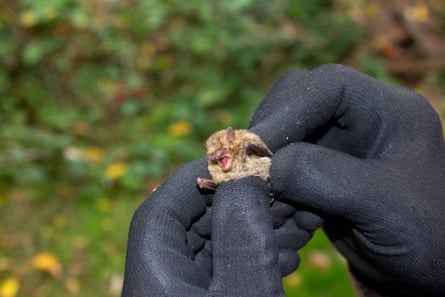“There are the most extraordinary things we could learn from them,” says Brian Briggs, as he checks yet another of the bat boxes that he and his wife, Patty, have put up just outside Heathrow. “They’re completely fascinating, from all kinds of angles.”
It’s a damp Sunday morning at Bedfont Lakes country park, and the Nathusius’ research project team, led by Patty, is checking the artificial roosters, looking at the health and number of different bat species. This outing, however, is a little different from normal; the conversation is focused not on the bats but on the government’s planning and infrastructure bill, which the following day will be having its final reading in the House of Lords.
The group believes the bill will undo decades of progress in the conservation of protected species. “They’re going to derail all the good conservation work that this country has been notable for,” says Patty, while noting down the bats she has found in the roosting boxes. “We need to look after what’s left.”

Patty is a conservationist, now in her 70s, who first became interested in bats in 1985, not long after bats were first protected in this country. “I started doing a lot of research into barn conversions and bats in barns. I remember going into one barn conversion and they were putting a new bathroom wall up. They discovered a bat and had the presence of mind to call someone, and I went there at dusk and discovered a colony of 30 natterer’s bats. If the builder carried on, he would’ve walled them in without knowing.”
Somehow, for the Briggs, bats became part of their life. “When Patty became interested in it, people began bringing injured bats to us,” says Brian, 80. “In my previous existence I had been an anaesthetist. The way people tried to anaesthetise bats in those days was to just put them in the fridge and allow them to go torpid. Which was not kind. So with a local vet and a local wildlife hospital we worked out a way to safely anaesthetise them.” They would, when possible, get the bats back to health and then release them again.
Checking along the bat boxes, just five in 37 are occupied: Patty says this is fewer bats than they normally see, and notes the absence of their usual nathusius’ pipistrelles.

“The bat boxes are often used as male mating sites,” says Patty. “A male bat will adopt a bat box as his, and anoint the entrance with his scent, then at night he will sing ultrasonically for all the girls who will join him for a party in his box.
“They aren’t disturbed by the planes. They live in an ultrasonic world.”
The planning bill that she and Brian are so anxious about has been designed by the Labour government to speed up housebuilding; the government says these “pro-growth changes” will accelerate its “plan for change”.
But concerns have grown throughout the process. Nature groups fear the bill will allow developers to plough through some of our most precious nature. In June, the Guardian highlighted 5,000 sites that could be at risk under the controversial bill, and in the last week several last-minute amendments have heightened anxieties.

“It’s madness,” says Brian. “How can you possibly tell if there are bats without going and having a look?”
Under the new law, developers would be able to build on protected sites and instead put money into a nature restoration fund, which would be used at a later date to create environmental improvements elsewhere. “It’s a pay-to-destroy system,” says Patty. “Developers will put money into a fund to pay for compensation, but it may be nowhere near an important colony which needs help.”
“If a colony loses the ability to meet up – maybe their wood has been cut down for a building scheme – the colony is fragmented into two groups. Then that small group is not able to generate the heat they need for the babies to grow and develop.”